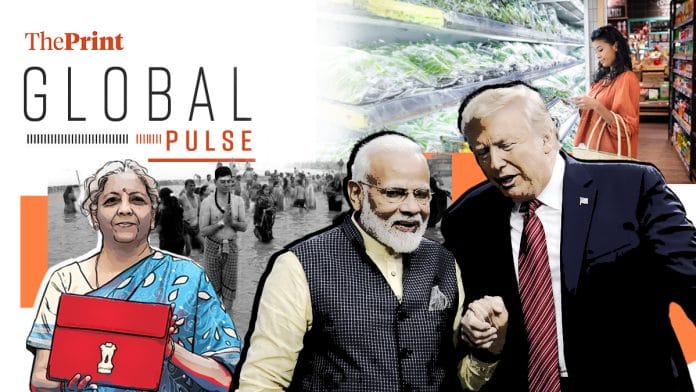New Delhi: The Financial Times declares India’s budget a “sweetener” for the middle class, aimed at reinvigorating the world’s fifth-largest economy.
Tax breaks for the middle class and measures to improve the ease of doing business are the main takeaways from this budget—and FT notes the emphasis on reviving demand among urban consumers, “a core political base for Modi’s BJP”.
The story describes how finance minister Nirmala Sitharaman announced new tax rates for the middle class while presenting the budget in Parliament, to the background score of ruling coalition MPs chanting “Modi, Modi”.
“Business groups have long urged India to reduce onerous paperwork and compliance burdens and reform the rules governing labour and land markets to stimulate investment and create jobs,” FT reports, adding that the budget focuses on relieving pain for the lower income and middle-income segments, where the distress is most acute.
“Despite strong infrastructure spending by the state, private investment has been sluggish and job creation weak. Inflation has been trending near the top of the Reserve Bank of India’s mandated band of 4-6 per cent, limiting its scope to cut lending rates.”
The other aspect FT highlights is the acknowledgement of a common refrain among market-watchers to India’s central and state governments: “get out of the way” and deregulate the economy.
The push for deregulation is part of a global trend, The Economist writes.
Grouping Prime Minister Narendra Modi along with US’ Donald Trump and Argentina’s Javier Milei, the story says that pledging to slash the red tape that tangles the economy is very much in vogue. “Narendra Modi’s advisers are quietly confronting India’s triplicate-loving babus,” the story says.
And “done right, the anti-red-tape revolution could usher in greater freedom, faster economic growth, lower prices and new technology,” it continues.
“This is a rare moment when politicians of all stripes have got religion. On the right, over-regulation has sparked a backlash that prizes economic freedom. On the left, politicians have realised that, with high interest rates and towering public debt, rapid growth is the only way to make welfare states affordable,” it says. “Yet the path ahead is strewn with pitfalls. The conundrum is how to be bold without being reckless.”
It doesn’t offer any further insights on Modi’s new budget, but uses Milei as a strong example: Milei’s team “wasted no time” in using bold strokes to reset economic expectations, and working out how to “extract the government from areas where it did not belong”.
Let’s see if either Trump or Modi actually follow Milei’s lead.
The New York Times takes yet another plunge into the world of the Maha Kumbh with a long ground report on what makes the mela a “mesmerising spectacle”.
The Maha Kumbh Mela is a “marketing opportunity like no other”, reports the NYT.
For Modi, “the Kumbh represents an important opportunity to advertise himself as the man who will transform India into a well-governed, efficient, tech-savvy and business-friendly heavyweight”. Modi has always been “keenly aware of the importance of image,” NYT observes. He’s not just a prime minister, he’s a “head priest”, according to Nilanjan Mukhopadhyay, whom NYT quotes.
What sets this kumbh apart from any regular festival is that it’s a “cultural and developmental showcase” rather than just a religious event.
“State government posters have advertised the Maha Kumbh as ‘divine, grand, digital’—a modern twist for a country that sees itself as a model of homegrown high-tech innovation,” reports NYT, pointing to the omnipresence of digital technology and its capabilities.
From QR codes for food and facial recognition technology to track missing people to digital billboards and ads trumpeting the “achievements” of the state government, the entire exercise is meant to show off digital sophistication, the story says.
Too bad the devotees are not beholden to the political nor organisational “marvel” of the Maha Kumbh Mela, the story notes. Religion is still the overwhelmingly strongest pull.
The Washington Post reports on how religion has become a polarising force among tribal communities who have lived beyond mainstream religion for decades now. The RSS has been active even in “dense jungles”, the Post reports, masking their religious objectives with developmental work in “schools, hospitals, technology centres, labour unions, even exercise groups and animal sanctuaries”.
The Post zeroes in on organisations that “seek not only to persuade non-Christian tribal people to identify as Hindu, but also to conduct what the Hindu right calls ‘ghar wapsi’, or “homecoming”: a process of “reconverting” Christian tribal people to their “original” Hindu status”. “These efforts exploit the “absence of the state”, as did Christian missionaries, but are also helped by government support,” it continues.
But there’s also a backlash among tribal communities in Chhattisgarh and Jharkhand, the Post reports. Non-Christian tribal people are “increasingly calling themselves nature-worshippers, not Hindus. The new flashpoint is a campaign for a separate religious category in the Census,” the story observes.
It’s an existential threat to tribals’ unique identity, and reduces tribal rights to simply being about religion, and not about land rights, disputes, lynchings and conflicts over places of worship and cultural festivals.
Also Read: Global media on India’s ‘talent economy’ & the persistent comparisons to China






